Joan Mitchell
by Cora Cohen Betsy Sussler
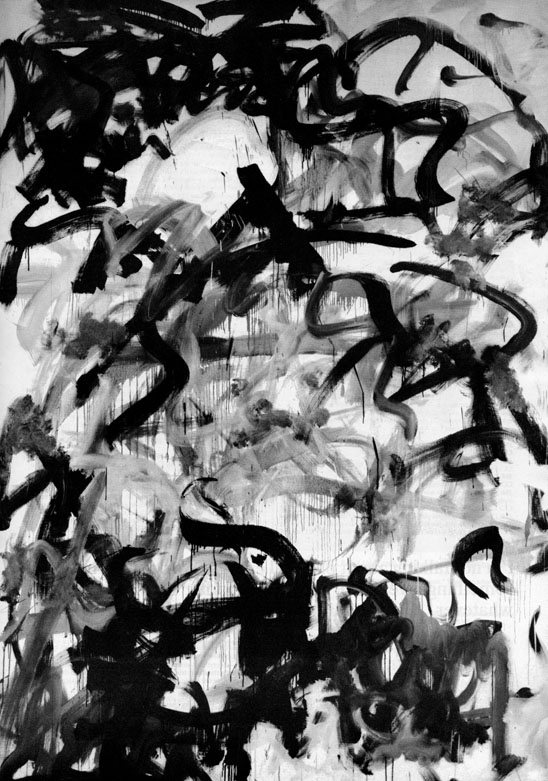
Joan Mitchell, Before, Again VI , 1985, oil on canvas, 110 × 78¾". Courtesy of Xavier Fourcade, Inc. All images © Estate of Joan Mitchell.
Joan Mitchell, the painter, lives in a house in Vetheuil, France, connected to the one where Monet painted in the latter part of the 19th century. She has lived and worked there for two decades. Prior to this time, she worked and lived in Paris and in the ’50s, in New York, where she was one of the youngest of the few women painters in The Club; the renowned enclave of New York painters whose membership included de Kooning, Rothko, Kline, and Pollock.
In the fall of 1985, Cora Cohen accepted an invitation to visit Joan at Vetheuil. While there, she asked if Joan would allow her to tape their conversations. Joan agreed, with reservations. "It’s hard to speak of paintings, it’s something you see . . . There are writers I like, Samuel Beckett, I have done some drawings for a book we were going to do together, a radio play, Embers . They are in my studio but why do it? Embers is perfect without them. Beckett used to say, ‘Why stain the silence with words.’"
The following fragments skirt around this silence. They are from the conversations at Vetheuil between Joan and Cora; conversations recorded at birthday dinners, while watching TV, or before walking the dogs. Joan is evasive, turning things back around to the interviewer, so we met one last time several months later, in the spring of ’86 in New York at the Westbury Hotel. Joan sighs, “Why do this again?” Cora wisely sat back, while I did most of the talking and Joan fenced, with a sly smile, "It’s just that interviews get so boring." We promised to keep them very short.
—Betsy Sussler, New York, 1986
VETHEUIL, FRANCE, OCTOBER 1985: THE TV ROOM, THE EVENING NEWS IS ON.
Cora Cohen I thought we could do everything.
Joan Mitchell You mean look at television and talk? It’s up to you. Just do your interview.
CC I got used to talking to you with the television on. After being here however number of days . . . don’t listen to it. I treat it like white noise. You have a certain amount of peripheral activity going on here.
JM Don’t you think vision can be peripheral, or don’t you think that dogs can be peripheral?
CC Dogs?
JM You have to be aware of where they are; what they’re doing . . . They’re downstairs and I know they want to go out shortly. Birds are singing away, or screaming at night, some of those weird birds we’ve heard, these are all peripheral.
CC Of course. I mention peripheral activity because it has an existence in your paintings as well.
JM I’m really unclear. It sounds as if you’re saying I like to do two things at once, like read and bake a cake, or talk to you and look at the news behind you, which is what I’m doing, exactly. But when I’m painting, I’m not reading. Oh, l might be, but once I’m starting to paint then I paint. I mean, I can’t even listen to music.
CC I know. I mean, I would imagine.
JM Or I don’t hear it until I’m not painting. It’s a security, sound. I sleep with a sound.
CC I was trying to think what I see in your work that has to do with blankness.
JM Blankness to me is absolutely no space, no silence, no sound, no . . .
CC No, it gives the other person leave to think. It’s about an element of trust of the outside world. There could be a pause and in that pause you could lose your audience, but you trust that you won’t.
JM I couldn’t care less if I did. An audience? You mean a spectator? Yves Michaud says a painting is not completed unless it’s looked at, or something to that effect. I don’t think that way. But when you said I make a blank and that gives the audience a chance to look—I suppose. I don’t get what you’re talking about. You said a blank was like white noise.
CC Well, in your work there’s this relaxation.
JM I get tired. I run out of paint.
CC You said they looked thin.
JM Sometimes they do and sometimes they are. By thin I don’t mean thin paint, I mean there’s no volume. What did I say?
CC You didn’t say that. You just said thin. Where the space is less packed, more attenuated. It’s beautiful when you do that, Joan. It’s like vastness. Or the space from the studio to the house with that tree between; because the tree is there we know it’s not empty yet there’s less objecthood involved in the rest of that space than there is at the tree. And it’s not manipulated.
JM The word blank is what bothers me. It has no image to it. Blank. It’s nothing, something on a typewriter; or a mind that’s nowhere.
CC But sometimes, that’s how you are.
JM That’s sort of frightening when one goes blank.
CC It’s not uncontrolled.
JM I’m not senile, no. It’s scary—the word.
CC Well, don’t you think there’s stuff in the work that’s scary? It does have something to do with free will.
JM Playing your own music in a silence.
CC There’s part of your paintings you have to look at awhile, things you can’t get in about a second. Your work isn’t instantaneous apprehension work where the best of what you can get out of it is what you get in a minute.
JM Actually, I’ve been told that quite often by people. It’s hard to figure out why it comes together or what I’m painting about. What is there exactly that makes it work? Now I’m not very clear about that and I don’t want to go into it too much. I’m not very clear why . . . But it’s been said how it’s very difficult, you said that to me, to understand—to put together one of my paintings. Once it comes together in the spectator’s eyes, then it’s there but it takes time to see it, to figure out why it’s there—the blank space, the line. Like a Meursault. You don’t get a hit fast on that and the taste is so wonderful.
It’s extremely hard to do, whatever I do. No, I don’t mean hard to do. It’s hard to squeeze paint if I don’t feel like it. If I don’t feel what I’m doing there’s no point in it. Real. Felt is the only word you’d say. There has to be meaning to what you’re putting on.
CC It’s obvious that it’s not manufactured.
JM And neither are my feelings and that’s what’s so hard about it all. Well, I can manufacture a painting. Can’t you? But I’d get bored. Can you work long? I can’t work long.
CC That’s basically how I like to work. I get into it and work for 12 hours.
JM What do you take—vitamins?
CC Well, it’s not all of the same intensity.
JM That’s what I mean. Some of it’s squeezing paint, or hammering stretchers.
CC No, not hammering. I can push the paint around 10 hours.
JM It must look awful after pushing it around. Do you get a kind of non-color, New York quality? I mean by 12 hours of pushing paint around you’ll have smog over Los Angeles.
CC You do not.
JM How do you do it? This is oil paint. Right?
CC That’s what I do.
JM That’s what I thought. How do you do it?
CC I work a lot wet into wet. What’s the matter?
JM I’m having a good time.
CC Because you’re baiting me.
JM C’mon, how do you work wet into wet for 12 hours and keep a fresh look. You don’t. You can’t. What do you get, that weathered look?
CC Joan, you’re not supposed to censure in advance.
JM I’m not talking about physical energy. Working from something given. The apple, the model, the still life, whatever . . . But to paint out of my own landscape and find it—I can’t find it more than four hours a day if I can do that.
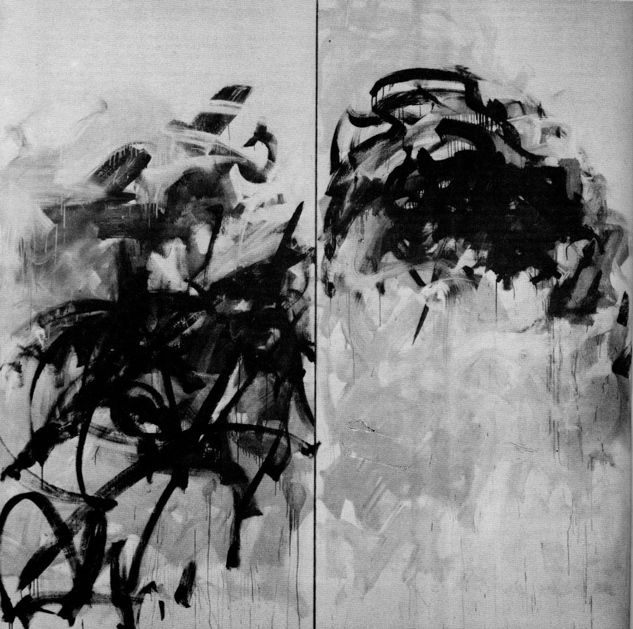
Joan Mitchell, Faded Air II, 1985, oil on canvas, 102 × 102" diptych. Courtesy of Xavier Fourcade, Inc.
JM You have trouble accepting help?
CC It’s more like an animal that you’ve found on the street. Say you find a cat on the street and take it in. It’ll settle down and you’ll feed it and do what you have to do about it and then—this has happened to me sometimes with animals—you’ll be petting it and all of a sudden it has a fit and starts clawing you. It’s not that it thinks you’re going to attack it or anything. It’s that it doesn’t know how to sort of bask in a kind of love or relaxation. And I think there was a longtime . . .
JM What a fabulous image.
CC I’m scared too.
JM Why are you scared? Why? Tell me that one. About succeeding—that God will punish you?
CC I’m also scared about being punished for being greedy.
JM This is that Talmudic God, right?
CC Well, I don’t know. You think that’s in my genes?
JM I don’t know. I don’t know which God you’re talking about. I don’t know anything about them but they all know me. Did you hear what I said?
CC Umm hmm. I’m scared of disappointment and rejection and all of that—it’s just not the easiest thing.
JM You’re talking about rejection. Don’t be worried about rejection. I say that now. It’s terrible, I asked one of my dealers years ago "If I don’t sell are you going to dump me?" And he said, “Sure.” But sales don’t make a show.
CC I know.
JM You don’t know. You don’t know the old times. Franz Kline said to me when I’d helped him bang a show at Sidney Janis, he said, "Tell everybody sold out." Then he whispered in my ear, “I only sold one painting.” Okay—he was full of humor.
CC I know it’s not just the selling. It’s just the easiest part to . . .
JM That doesn’t mean it’s good, bad or anything . . .
CC I know, what do you think I am?
JM I don’t know. I think you’re a little girl going into her first ice skating competition and scared like hell she’s going to fall flat on her face in Madison Square Garden.
CC Yeah, well that sounds good.
JM And I’m being my mother to little Joan and I’m saying—so you fall.
CC Alright, I’ll remember.
JM Oh, my mother was nice to me. I mean her idea would have been your mother’s idea; why try, why go out and compete in Junior Nationals, Senior Pairs. You know what I mean. Why don’t you have a good time, Joanie, why don’t you just skate and have a good time? It seemed very boring to me to do something for a good time because I didn’t know how to have a good time. Does that mean anything to you? . . . I had a wonderful time yesterday with those people and today I was depressed because I felt I shouldn’t have had that good time or something. I don’t know how it seeps in, the punishment of having something—not painting. Or you know, I’m happy when I’m painting. I like it.
VETHEUIL, FRANCE, 1985 JOAN’S STUDIO
JM To me, figure/ground means a use of space. It has nothing to do with a figure sitting on a Greek pot.
CC But when you say “ground” and you say “figure” and you’re not talking solely to people who went to school with Hans Hoffman . . .
JM Well, how would you like to talk about it? I think that if the figure/ground doesn’t work in a painting—I’m not talking about my painting but painting in general—I’m not very satisfied with it. Now if I have a blank space in there and it isn’t working as a positive space, as well as an unpainted space, then I’ll take it out or paint it in.
CC I think those things are good if you’re being kind of nitty-gritty and in the studio saying, ‘Well, maybe the upper right should come forward a little.’
JM Well, you’re damned right. If it doesn’t come forward enough, let’s fix it up.
CC Yeah, it’s not like I don’t look at things that way, it’s not like I don’t work that way, and I do not feel very interested in paintings that don’t make it in those terms.
JM In the olden days one would simply say—It doesn’t work. Why not? Well, the yellow is jumping or the blue is going away. Long before painting became such a part of a consumer world. So, I guess that’s what they turned into figure/ground. Painters used to talk to each other before you were born by saying, ‘Gee it doesn’t work. What’s the matter with it? That blue is jumping or whatever." That’s all. And then they turned that into figure/ground. Picasso didn’t talk that way. All he was concerned with was figure/ground by the way.
CC I don’t think that this painting, for instance, is important because it successfully achieves a figure/ground relationship.
JM Oh—everything around here achieves a figure/ground, who cares about that? That’s absolutely true. Because then you have to put to the poppies and the parasol, or the picnic on the grass, right? You have to do something. Oh, sure.
CC I really like this one.
JM I do too. That’s why I hesitate to fill in some of that blank. I know exactly what I might go in with—it has to be just right.
CC What?
JM I’m not going to tell you.
CC Why not?
JM Because I hesitated and didn’t because I wasn’t sure. A painting is like an organism that turns in space. I wasn’t sure . . . I will. A little something up there. And I want to do something here. I might scumble it in very little like lavender and yellow . . .
CC You mean that green in the upper left?
JM Yes, and then I’d see how it would go into these blank spaces.
CC Have you gotten to like the idea that they’re blank, or is that in quotes? You keep calling them blank spaces. Are you developing a little affection for that nomenclature?
JM It’s like a restroom on the auto route. Isn’t that a wonderful word, ‘restrooms,’ where you go pee.
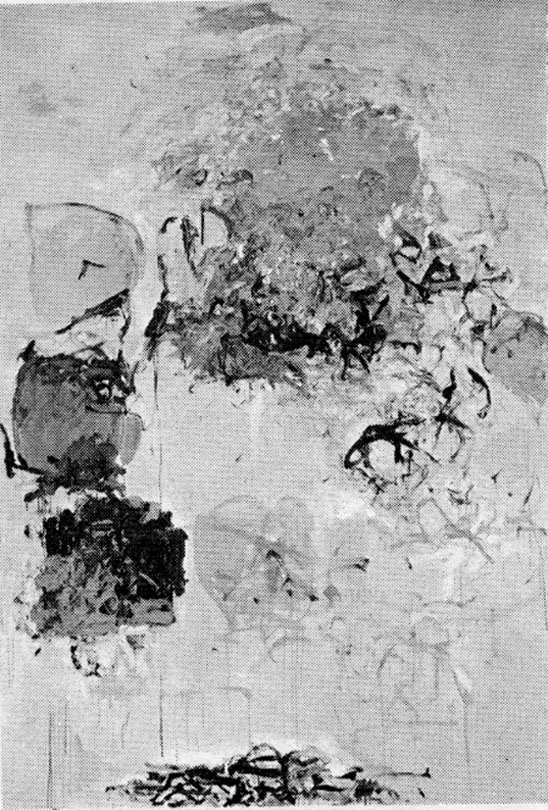
Joan Mitchell, Sunflower II, 1969, oil on canvas, 112 × 79". Courtesy of Xavier Fourcade, Inc.
VETHEULL, FRANCE FALL 1985
JM I hate what you just said. It’s so typical New York.
CC What?
JM ‘The new season.’ Sounds like couture. You know? Fashion. The new season is going to be this, and that’s what it is. The art world has become the new season. What are they showing this year? Which is quite the opposite of, you know, carrying a painter. You know what I’m trying to say.
CC Yeah, it’s upsetting.
JM I mean, you’re in the situation. ‘The new season.’ You hear what you’re saying.
CC Yes.
JM I mean, it’s so repulsive.
CC Well, you think I like it? Look, I’m going to still be in that studio making the paintings and trying to do what I have to do about them whatever happens. That’s the answer.
JM I never had to do that.
CC You never had to do what?
JM Find a gallery.
CC I’m sure you had to do a few things, though, that maybe you didn’t want to do. Everything wasn’t just handed to you. You might have done a little work besides stay in the studio.
JM It was done for me—by someone. Somebody spoke to somebody and they came down to see my work.
CC That’s usually how things happen. But unless you speak to somebody first, they’re not going to know the work’s there to be spoken about to someone else.
JM Then, wasn’t like now. You painted and you know . . .
CC Really Joan?
JM Well, I don’t know. One had 40 people, 50 people to deal with.
CC You mean, you think it was easier.
JM Not to get a show and not to make money because there were very few galleries to make money for women. It wasn’t . . . People encouraged each other, looked at their paintings. The artists didn’t try to keep somebody away from somebody. Everything returns. Gandy Brody, for example. Bob Beauchamp, he’s been out in the boondocks for years and now he’s selling like mad, which is great. He’s my age. Or George McNeil. Because there was minimalist and expressionists and the isms, and the isms. If you can hold out, you can make it. Maybe not for the next season,
CC I’m going to be both. I’ve always thought I could be both.
JM Fine sweets. You want it all ways. You’re a spoiled girl.
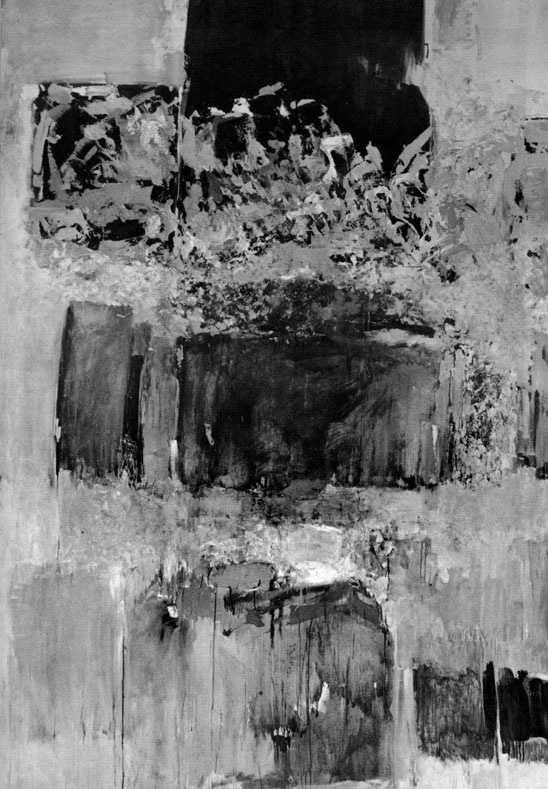
Joan Mitchell, La Rupture De La Ligne, A Poem by Jacques Dupin 1970-71, oil on canvas, 112 × 79". Courtesy of Xavier Fourcade, Inc.
NEW YORK CITY, SPRING 1986, THE WESTBURY HOTEL
JOAN MITCHELL AND BETSY SUSSLER. CORA COHEN IS PRESENT
Betsy Sussler Joan, you paint with music, poetry, and your dogs. When the dogs watch you paint do they sit, very quietly and stare, sphinx-like?
JM How do you know that? It’s true. Do you like dogs?
BS A painter friend of mine had a beautiful white Saluki who would drape itself over the couch in the studio and watch in that way.
JM They’re very decorative Saluki’s.
BS This one wasn’t. Do you think dogs can be mediums?
JM No. These dogs just want to be with Joan. They sleep, one, two, three on their bed in the studio and if I’m not really concentrating they get twitchy and all that.
BS Don’t you think they watch you paint?
JM Well, the mother—there’s certain music she really doesn’t like.
BS And you change it immediately.
JM Of course. She doesn’t like Stockhausen.
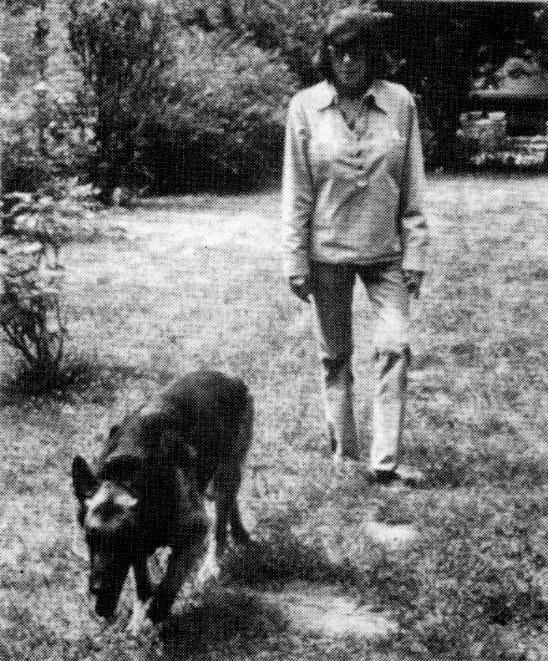
Joan Mitchell at Vetheuil, © Edward Boubat.
BS Your paintings like Cous Cous and Blueberry (1961–62) look as if you’ve taken these foods and turned them inside out. Splattered them across the canvas.
JM That was years ago. I don’t remember which painting Blueberry is.
BS It’s sort of character development. Instead of building elements to develop subject, you brush the texture of a blueberry apart.
JM No, that’s the title.
BS You title them after they’ve been painted.
JM Yes.
BS Why call it blueberry then?
JM Somebody gave me that title. We sat around and had ‘title evenings.’
BS What’s a title evening?
JM That was a long time ago.
BS The paintings from 1985, Between, Faded Air Before, Again—these are titles between time-moments that evaporate.
JM I was sick, so one was before and then I had to have an operation, so the next one was between . . .
BS You were marking time.
JM I’m trying to stop time, or frame it.
BS Do you think there is a synthesis—a moment when there is no separation between life and death?
JM Well, if you want to go into it in time—of course—daylight, night light. All is in time. What is death but time?
BS Actually, from looking at your paintings, I thought you thought death was light.
JM Read that again. Light is light.
BS Life continues decay, a dust, a leftover or premonition, a memory . . . In your descriptions of sunflowers . . .
JM I was just saying that . . . Oh, just read it.
BS Joan, I don’t want to copy other interviews. Okay, there’s an effervescence to light that could be associated with life and great joy which your paintings contain.
JM Cora, are you uncomfortable?
CC No, I’m fine.
BS . . . And light in time and space contains past, present, and future. And future also contains death.
JM It sure does. (laughter)
BS So when I look at your paintings and see a concentration of light . . . There’s a text by Coleman Dowell that describes the fauna he passes as he walks through the forest with another being . . .
JM Robert Frost’s "And miles to go before I sleep/And miles to go before I sleep." Or, “And if I die before I wake/I pray the Lord my soul to take.”
BS You use a very concentrated yellow pigment, a yellow dust, in the sunflower paintings. Dust to dust. You also talk of a sunflower’s sadness as it is wilting—there is great dignity in their death.
JM Ummm.
BS Is that what drew you to them?
JM Do you know them?
BS I look at them a lot—out on Long Island.
JM The very big ones are one way and yet some of them come out like young girls, very coy . . . they’re very human.
BS You use a white ground. Why white, rather than blue or black?
JM I think of color literally. White is white, black is black, and light isn’t necessarily color.
BS But it contains color, white light is all colors, like the spectrum.
JM I thought black did that. Look, a lot of paintings use white without having light. Either a painting has it or it hasn’t. Franz Kline has light, Matisse has it, Monet doesn’t, the Expressionists don’t.
BS Why this search for light? Are you capturing light, or making light? vJM No, the painting has light. It’s not a tonal painting from light to dark.
JM No.
BS It’s just the air-atmosphere.
JM As light?
CC If it were like God, I’d think of it more as pantheism.
JM Sure, love is God or love equals light. God is a manmade—something.
BS I’m not talking about God as another being who exists. I’m talking about this search . . . This need for faith, to hold things, for love.
JM Rothko has that I guess.
BS Your brushstrokes are in suspension, a state of grace. There’s a sensuality to the way you apply paint.
JM I don’t dislike the word sensual. BS Oh, you don’t like the word evoke.
JM Just not in connection with my work—I’m not religious. I love Notre Dame, but heaven and hell . . .
BS I’m not talking about state religion. There is a quality in your brushstroke that is almost pagan—a freedom of worship that is very physical and intimate. Do you think there is a connection between the sensuality of placing the paint and the emotions that are evoked?
JM Yes, I care. The way Matisse puts paint on—I want to paint well, physically. That’s what I mean by paint quality, Mondrian, Matisse.
BS It’s touch. Do you think paintings contain memories of things—an atavism.
JM Like a computer? You can see, in some paintings, how you have arrived which is a process.
BS I’m talking of objects having a life of their own.
JM Do you like Wordsworth? Do you think a tree makes a sound in the forest when you’re not listening?
BS Yes, I believe they do. Do you?
JM Oh, certainly. The fact that you’re looking at them might stop them from making a sound.
BS Don’t you think paintings have that same quality?
JM When I was little we had bright yellow curtains in the library and when we went away for the summer, they were put in a box. And I imagined them in that box, glowing, all summer long.
POSTSCRIPT FROM A LETTER IN AUGUST, 1986
Joan writes, Rilke (Malte Laurids Brigge—The Notebooks of), for example is about what I mean. He is so fantastic. Hugo von Hoffmannstahl (The Lord Chandos Letter) also. Much more than Wordsworth now.
—Cora Cohen is a painter living and working in New York. Her work will be showing at the Jeffery Hoffeld Gallery in the spring.
—Betsy Sussler is the editor and publisher of BOMB.